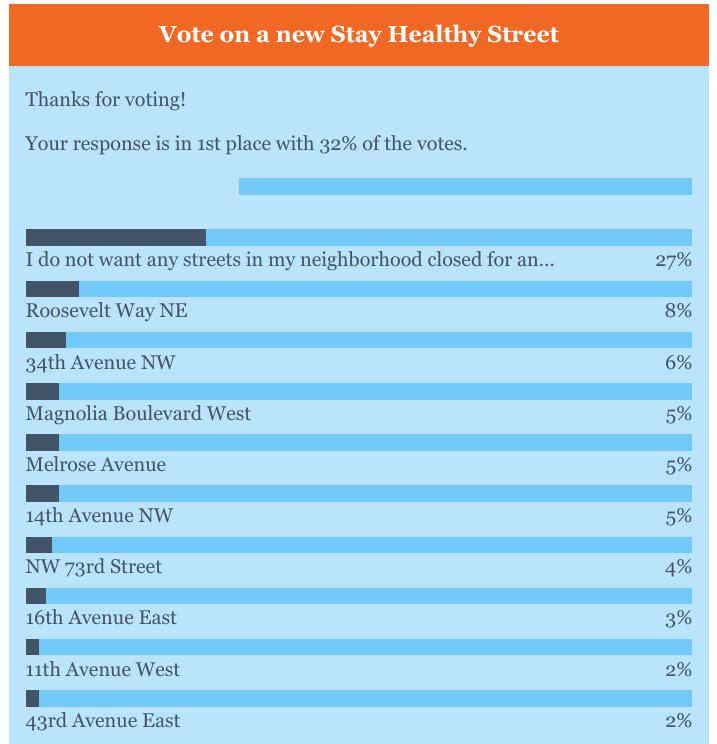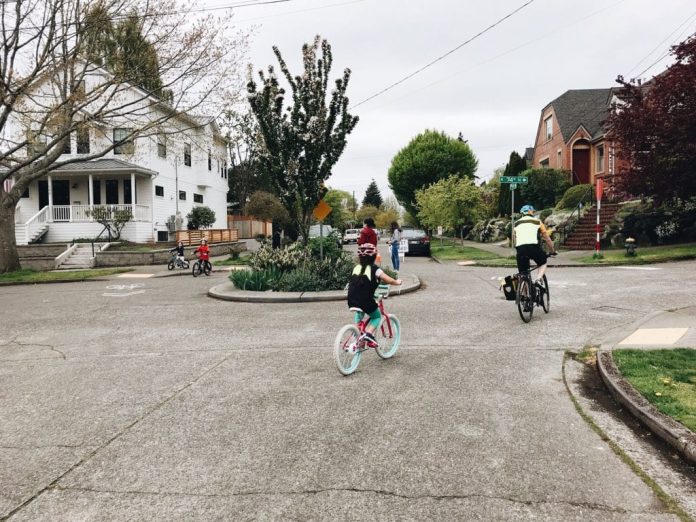On Wednesday, The Seattle Times published a story on plans to expand the Stay Healthy Streets program that included an online poll to guage the popularity of new additions. A whopping 73% of respondents supported adding Stay Healthy Streets over “I don’t want any streets in my neighborhood closed…”
The top response at of noon today was Lake Washington Boulevard, which was selected by 32% of respondents–by far and away the most popular addition. The street was included in Seattle Neighborhood Greenways’ expansion plan (which The Urbanist endorsed). Greenways proposed closing the northbound travel lane to cars to expand space for people walking, rolling, and biking–who compete over a narrow sidewalk leading to unsafe situations, both for social distancing and avoiding motorists speeding down the bouelevard. Traffic cones and barriers would cordon off the southbound lane, which would remain open to cars in order to allow access to the driveways fronting the lake.
The other most popular additions were Roosevelt Way NE, 34th Avenue NW, Magnolia Boulevard W, Melrose Avenue, and 14th Avenue NW–all of which claimed at least 5%. Readers could only select one of 11 choices in the poll which were the top choices among more than 100 submissions in response to an earlier traffic lab installment, author Michelle Baruchman noted.
The list has considerable overlap with the Seattle Neighborhood Greenways’ proposal, including 14th Avenue NW and 34th Avenue NW in Ballard, Capitol Hill’s Melrose Avenue, and Magnolia Boulevard (with it sweeping views of Puget Sound and the Downtown skyline). Roosevelt Way NE (in the U District) actually wasn’t on Greenways’ proposal, but 12th Avenue NE a few blocks away was.
The show of support in The Seattle Times poll was all the more heartening because the framing of the Stay Healthy Streets wasn’t all that favorable. The headline and the poll took the windshield perspective of a “closing” of street rather than opening the street for people to walk, roll, and bike in comfort, safety, and social distancing, highlighting the loss rather than the gain.

Modern laws have generally made walking in the street illegal. Before the car came along, the crime of jaywalking was just everyday walking except without all the unnecessary right angles and beg buttons. “Stay Healthy” open streets take transportation system back to its roots when the default user of a street was a pedestrian–hence the frustration from safe streets activists when open streets are pronounced “closed” since the “to whom” always defaults to cars.
The fear for people who want to keep status quo car-dominated streets seems to be that once people experience the alternative, they really like it. This may explain the popularity of an open street on Lake Washington Boulevard, which already gets opened to people biking, walking, and rolling on select Sundays in normal years as part of the City’s Summer Parkways program. Familarity could be what is leading to its popularity–and it doesn’t hurt that it’s an exceedingly pleasant ride/walk, with views of the Cascades and plenty of green space along the way since it was designed as a linear park.
Still, I expect you’ll find many streets–even without the advantages and unique history of Lake Washington Boulevard–can make the leap from being thought of as sewers to maximize car throughput to something closer to linear parks for people. We just have to free ourselves from our ingrained windshield perspectives to see the greener and most pleasant possibility right in front of our noses.
Framing quibbles aside, the Times article ultimately advances the cause of Stay Healthy Streets by showing that Seattle–even lumping in people from surrouding suburbs that make up the majority of The Seattle Times readership–are supportive of adding more open streets in Seattle.
We can see Stay Healthy Streets popularity in political support too. Mayor Jenny Durkan and most Seattle City Councilmembers have embraced the program and expressed support for adding more open streets. Councilmember Andrew Lewis, for example, said he supports Seattle Neighborhood Greenways’ expansion proposal for District 7.
It seems like the open streets movement is building momentum, but we certainly don’t want to let up or take anything for granted. Sign your support via this Seattle Neighborhood Greenways’ form to keep the pressure on officials to follow through.
Doug Trumm is publisher of The Urbanist. An Urbanist writer since 2015, he dreams of pedestrian streets, bus lanes, and a mass-timber building spree to end our housing crisis. He graduated from the Evans School of Public Policy and Governance at the University of Washington in 2019. He lives in Seattle's Fremont neighborhood and loves to explore the city by foot and by bike.


